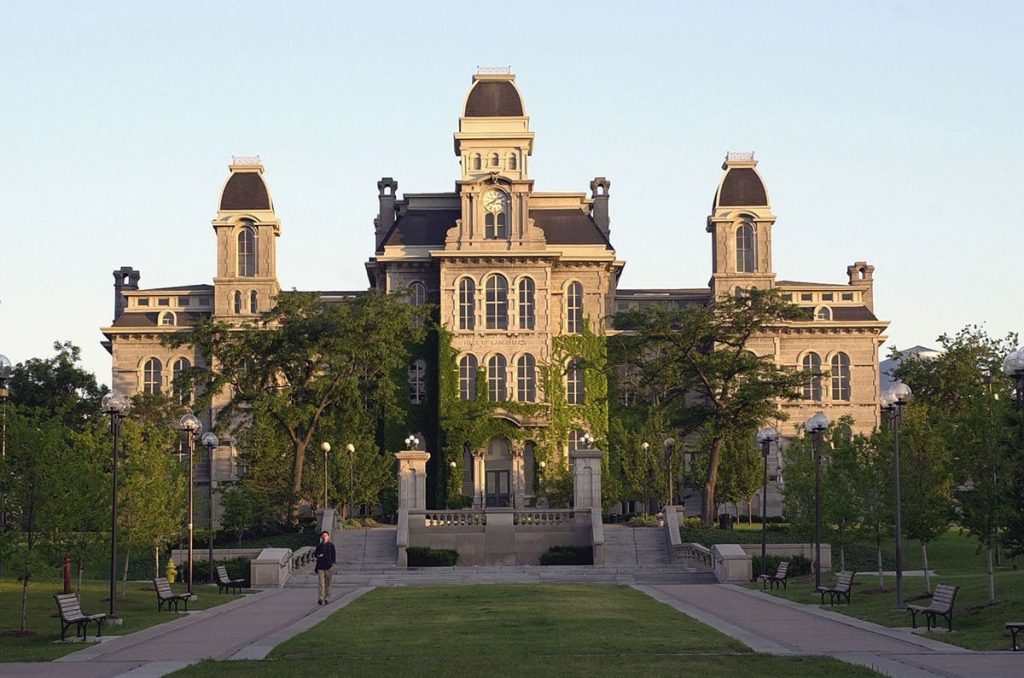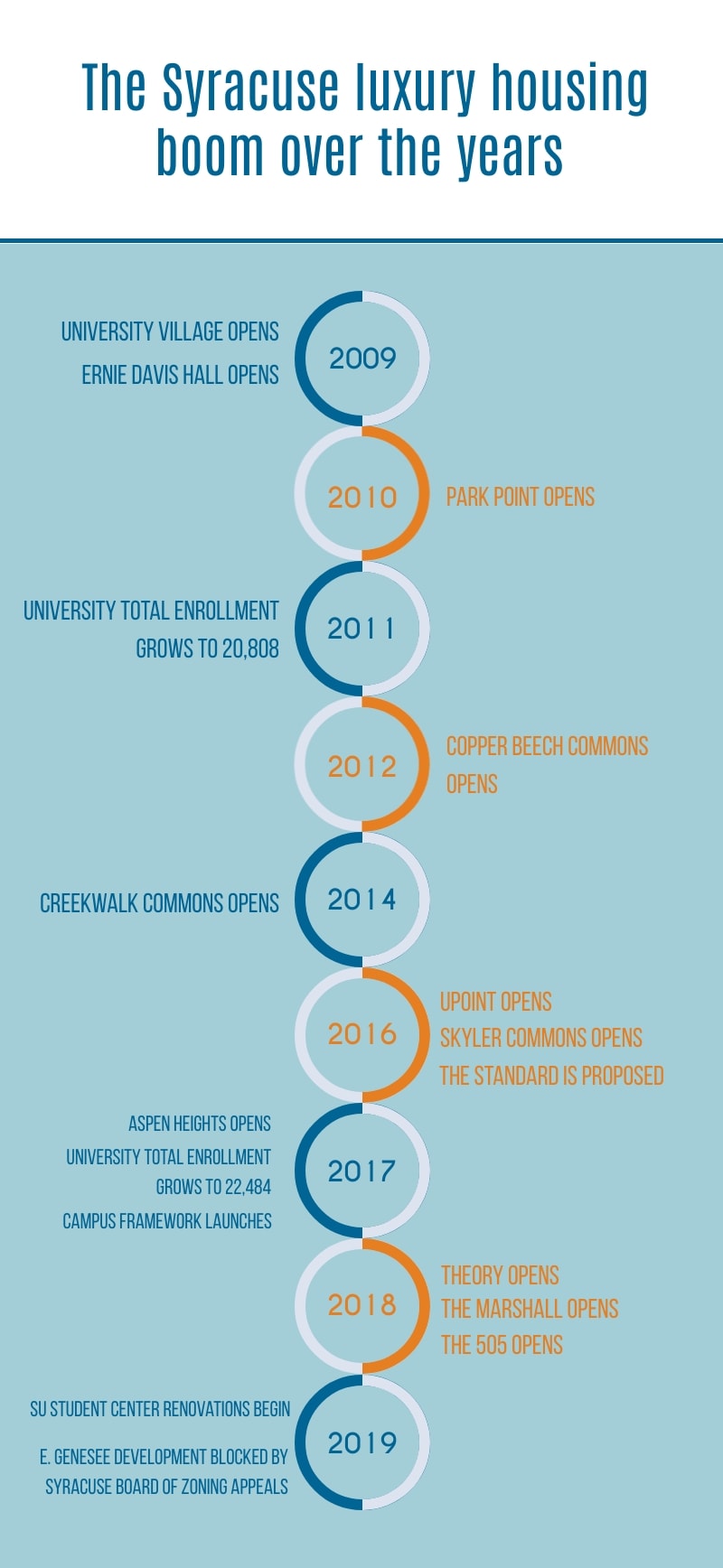New off-campus housing could influence retention at SU
New off-campus housing could influence retention at SU

In 2016, former Syracuse University Associate Vice President Eric Persons wrote a letter to the Syracuse Zoning Board of Appeals, imploring the city to reject a real estate proposal for a 17-story, 300,000 square-foot commercial and living space on East Adams Street and University Avenue called The Standard. The university, Persons wrote, was “deeply concerned about the potential negative impact these projects will have by dramatically shifting residents away from one neighborhood and into another.” But three years later, The Marshall, an eight story and nearly 170,000 square-foot complex of retail and living space, went up on South Crouse Avenue, creating a red and gray blockade between SU and the city, without a public peep from the university.
The Marshall was not the first major luxury student housing project to appear near SU, and it may not be the last. But SU’s voice, perhaps the most influential in Syracuse, is missing in the public debate about real estate development. The university plays a substantial role in the decision making for what gets built near the campus area, historically using its voice to give yays or nays on project proposals. In 2012, the then-head of the city’s business development office called the relationship between SU and the city “symbiotic.” In short, nothing happens near the SU campus without SU approval. But just as SU’s concern may have killed The Standard proposal, the university’s silence as new building projects are proposed is just as powerful.
The first luxury building, University Village, opened about a decade ago on SU-owned property on East Colvin Street. Though subsequent apartment buildings were built by private developers off campus, the university can benefit from their presence.
SU’s Academic Strategic Plan (2015) and Campus Framework (2017) map out what the university wants to accomplish in the coming decades. Large scale structural goals at SU include renovating the student center and creating a compact “campus-city” community. The structural goals will ideally influence the less physical goals, like school reputation and student experience. A positive student experience, according to the university’s strategic plan, will “create the conditions that support excellent teaching, learning, retention and success.”
Retention is important to universities in many ways, including rankings. High retention rates signal happy students. But it also means steady tuition dollars, and every tick down in the retention rate represents revenue leaving campus. For example, in Fall 2018, 90 percent of the 3,638 students who entered as first-years in 2017 came back for sophomore year, according to SU’s Office of Institutional Research. Given current tuition rates of $52,210, the 378 students who left represented $19.7 million in missing tuition dollars. And that’s just for one academic year.

Housing can play a significant role in retention and student success. According to the U.S. Department of Housing and Urban Development’s Office of Policy Development and Research, “students appear to be more likely to graduate if they live on campus, particularly when the on-campus experience encourages student learning and engagement.” Syracuse University acknowledges this mentality in the Campus Framework, noting that first and second year students required to live in university housing will be consolidated on Main Campus, close to classes, gyms and everything else a student could need. Proximity to campus is critical, says Dr. Amir Hajrasouliha, an assistant professor of city and regional planning at Cal Poly who studies student housing and retention. “The whole point of campus housing is that it makes all the resources on campus accessible to students. If they are far away and have to drive or spend time getting the bus, that will really diminish the impact on-campus living can have,” Hajrasouliha said. “Just having dorms is not enough. Where you put those dorms or housing is important.”
For a student who lives in one of the more popular complexes, their lives are compact and convenient. The Marshall and Park Point are less than a third of a mile from Schine Student Center. The 505 on Walnut and U Point are no more than half a mile.
Students who live in nearby off-campus housing may benefit as much as students who live on-campus, said Reid Ewing, a professor of city planning at the University of Utah, who collaborated with Hajrasouliha on their 2016 study of campus design and retention. “The variable that proved significant in both retention and graduation was the availability of housing on campus,” Ewing said. “If I had to guess, on-campus housing has value in and of itself, and placing housing off-campus, but within a short walking distance, is an equivalent to having students live on campus.”
One of the five key recommendations found in the 2017 Campus Framework is the creation of a “campus-city” community. The report stresses that Waverly Avenue will be transformed into a “gateway” to the university, emphasized through new building facades and a mixed-use residential building that will bring the city to SU. Nearby luxury apartments like The Marshall and U Point play a part in the campus-city community, but at no cost to the university.
Devoloper Jared Hutter, who built those two apartment buildings, says the updated housing benefits students, and therefore the university. “They talk about getting rid of South Campus. They need to. That stuff is old and barren. They force people to live there, but people don’t want to live there,” Hutter said. “The university always talks about the student experience, but where kids live and study is a huge part of that.”
Syracuse University did not respond to repeated interview requests for this story.
But Don Saleh, a former vice president of enrollment who left the university in 2014, said SU could reap retention benefits from a student experience enhanced by luxury student housing, even if it is off campus, and not university owned or controlled.
“That’s absolutely a positive,” Saleh said. “I think it would play into that strategic goal.”








